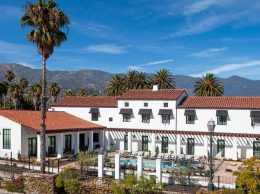Dubroff: Central Coast technology hub makes a quantum leap
IN THIS ARTICLE
- Central Coast Topic
- Henry Dubroff Author
By Henry Dubroff Friday, October 25th, 2019
At the height of the dot-com bubble, the Central Coast made news because the Santa Barbara area had more domain name registrations per capita than any city in the nation.
Twenty years later, there is talk about a new dot-com bubble and the Central Coast is in the news again.
On Oct. 23, Google’s parent, Alphabet Inc., announced that its research lab in Santa Barbara reached what it described as “quantum supremacy” or the ability of a quantum computer to perform a complex computation much faster than any existing supercomputer.
In a widely quoted excerpt from the scientific journal Nature, Google said that its South Coast lab had performed an operation in three minutes and twenty seconds that would have taken the newest and fastest computer 10,000 years. In a blog post, Google engineering director Hartmut Neven wrote about “the beginning of a new journey: figuring out how to put this technology to work.”
As competitors like IBM were quick to point out and Neven’s post implies, there’s a big difference between announcing a single computation and creating a commercially viable product using quantum chips. And the breakthrough comes at a time when Wall Street is once again pivoting from embracing growth at any price to a new focus on profits.
The best example is the financial rescue of WeWork by investor SoftBank, a move that has called into question the viability of SoftBank’s $100 billion innovation fund and has put renewed focus on profitability as a key metric.
But the Central Coast is a different sort of innovation hub than it was 20 years ago when wealthy denizens in Montecito and Hope Ranch were registering domain names by the dozens in hopes of cashing out quickly and where a handful of tech firms commanded super high valuations.
A few thoughts about the tech scene in the wake of WeWork’s meltdown and Google’s big quantum computing announcement:
• Some public company risk has already come off the table. The recent meltdown in shares of oxygen concentrator maker Inogen means that expectations are much more in line with the company’s actual financial performance. MindBody’s go-private transaction with Vista Equity Partners removed one of the riskiest of the region’s unicorns.
• Public markets are setting aggressive targets for recently public companies like AppFolio and The Trade Desk but they continue to meet expectations. And Wall Street is treating companies like Amgen differently; the biotech giant is showing up in value-oriented mutual funds thanks to its dividend and focus on cash flow.
• Venture capital continues to recognize the strengths of the region. The Santa Barbara-San Luis Obispo corridor’s expertise in marketing-software-digital technology got a nod when Invoca landed a major investment.
Likewise, the Westlake Village biotech corridor garnered a major investment for Arcutis Biotherapeutics, developer of new therapies for psoriasis.
What underpins the Google investment in Santa Barbara’s quantum computing lab is the continued evolution of UC Santa Barbara’s materials science expertise. That has brought innovation in LED lighting, in solar film, and in Apeel Science’s food preservation technology.
What happens next is anybody’s guess.
But the portfolio of tech companies on the Central Coast is a lot more diversified than it was a couple of decades ago. And if quantum computing is going to be the next big thing in the global technology wars, then UCSB spinoffs could make the Central Coast a major player.
• Contact Editor Henry Dubroff at [email protected].












